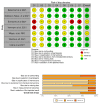Functional and Psychological Changes after Exercise Training in Post-COVID-19 Patients Discharged from the Hospital: A PRISMA-Compliant Systematic Review
- PMID: 35206483
- PMCID: PMC8871540
- DOI: 10.3390/ijerph19042290
Functional and Psychological Changes after Exercise Training in Post-COVID-19 Patients Discharged from the Hospital: A PRISMA-Compliant Systematic Review
Abstract
Millions of people worldwide are infected with COVID-19, and COVID-19 survivors have been found to suffer from functional disabilities and mental disorders such as depression and anxiety. This is a matter of concern because COVID-19 is still not over. Because reinfection is still possible in COVID-19 survivors, decreased physical function and increased stress and anxiety can lower immune function. However, the optimal exercise intensity and volume appear to remain unknown. Therefore, the current systematic review aimed to evaluate the effect of resistance or aerobic exercises in post-COVID-19 patients after hospital discharge. We conducted searches in the Scopus, SciELO, PubMed, Web of Science, Science Direct, and Google Scholar databases. Studies that met the following criteria were included: (i) English language, (ii) patients with COVID-19 involved with resistance or aerobic exercise programs after hospital discharge. Out of 381 studies reviewed, seven studies met the inclusion criteria. Evidence shows that exercise programs composed of resistance exercise (e.g., 1-2 sets of 8-10 repetitions at 30-80% of 1RM) along with aerobic exercise (e.g., 5 to 30 min at moderate intensity) may improve the functional capacity and quality of life (reduce stress and mental disorders) in post-COVID-19 patients. In addition, only one study reported reinfection of three subjects involved with the exercise program, suggesting that exercise programs may be feasible for the rehabilitation of the patients. A meta-analysis was not conducted because the included studies have methodological heterogeneities, and they did not examine a control group. Consequently, the results should be generalized with caution.
Keywords: COVID-19; COVID-19 patients; SARS-CoV-2 virus; coronavirus disease; mental health; psychological changes; rehabilitation; resistance and aerobic exercise.
Conflict of interest statement
The authors declare no conflict of interest.
Figures
References
-
- Aubert O., Yoo D., Zielinski D., Cozzi E., Cardillo M., Dürr M., Domínguez-Gil B., Coll E., Da Silva M.I., Sallinen V., et al. COVID-19 pandemic and worldwide organ transplantation: A population-based study. Lancet Public Health. 2021;6:e709–e719. doi: 10.1016/S2468-2667(21)00200-0. - DOI - PMC - PubMed
Publication types
MeSH terms
LinkOut - more resources
Full Text Sources
Medical
Miscellaneous



